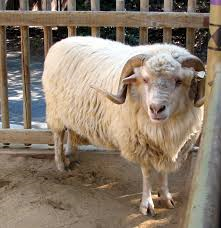Type the name of the breed you're looking for below
[wpdreams_ajaxsearchlite] Don't see the breed your're looking for? Click here and let us know!
Navajo-Churro sheep
| Place of Origin | United States |
| Origin | The Navajo-Churro, or Churro for short, is a breed of domestic sheep originating with the Spanish Churra sheep obtained by the Navajo Indian, Hopi and other Native American tribes around the 1500s during the Spanish Conquest. The breed is renowned for its hardiness and adaptability to extremes of climate. Its wool consists of a protective topcoat and soft undercoat. Some rams have four fully developed horns, a trait shared with few other breeds in the world. The Navajo-Churro has also gained popularity with its low-maintenance reputation, resistance to disease, and lean meat. Some say they are very personable. Ewes often bear twins. This breed, also known as the American or Navajo Four-Horned sheep, is raised primarily for wool. Navajo-Churro are descended from a cross between the Churra, an ancient Iberian breed and the Jacob Sheep, a breed found in ancient Biblical History. The Churra (renamed Churro by American frontiersmen) was first imported to North America in the 16th century and used to feed Spanish armies and settlers. By the 17th century Churros were popular with the Spanish settlers in the upper Rio Grande Valley. Flocks of Churros were also acquired by the Navajo through trading. The Churro soon became an important part of the Navajo economy and culture. A series of United States government-sponsored flock reductions and cross-breedings decimated the Navajo flocks until the Churro sheep nearly disappeared. Restoration of the breed began in the 1970s when breeders began acquiring Churro phenotypes with the purpose of preserving the breed and revitalizing Navajo and Hispanic flocks. While the Navajo-Churro breed is no longer in danger of extinction, Navajo-Churro sheep are still considered a rare breed. |
| Purpose | Fiber |
| Characteristics | Churros come in a variety of colours, including reds, browns, black, white, and mixes, and colour may change with age. The colour is separated into fleece colour, and the points colour (legs and head). The sheep may also have different colour patterns, such as eye patches and hip spots. The Navajo-Churro breed rams can have two, four, six, or more horns. This is because they possess the polycerate gene, which is also found in old heritage breeds like the Jacob Sheep. They also have the ability to have fused horns. Ewes (females) also can have horns, or nubs called scurrs. The colour can be black, white, or striped. The growth of rams’ horns is slow. A full rack takes at least four to five years to grow out. A ewe's horns can also grow large, but not to the extent of the rams. The horns often curl around to the front, and should be away, and not close to the face. The horn quality is essential to getting good genetics in a flock; bad horns in the sire will continue down through his offspring. Horns can break, and as they are living at the base, they will bleed. The Navajo-Churros possess a dual coat, which has an inner and an outer layer. The fleece is composed of an inner coat (80% of fleece), and outer coat that is hair fibers (10-20% of fleece) and kemp (a coarse, opaque fiber, less than 5% of fleece). The fleece colour is separated from the points colour. The fleece can often change from lamb to adulthood. Blacks, for instance, often white out with age. The Navajo people have used Churro fleece in rugs and other weavings for some time. The wide range of natural colours makes it easy to have a variety of colours without the need for dyeing, although natural vegetable dyes are sometimes used to produce deeper colours and wider selection. |



